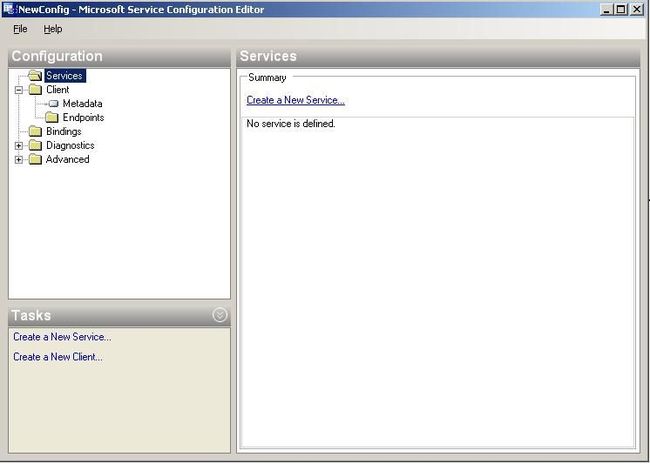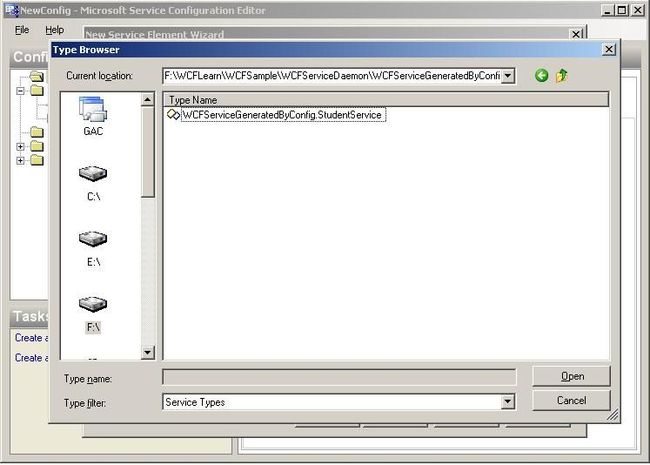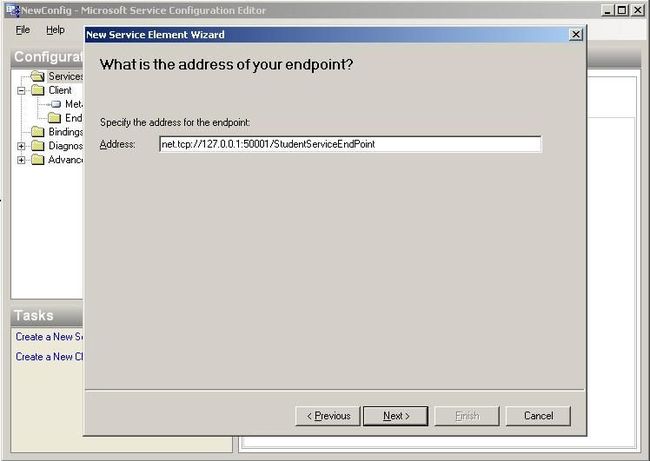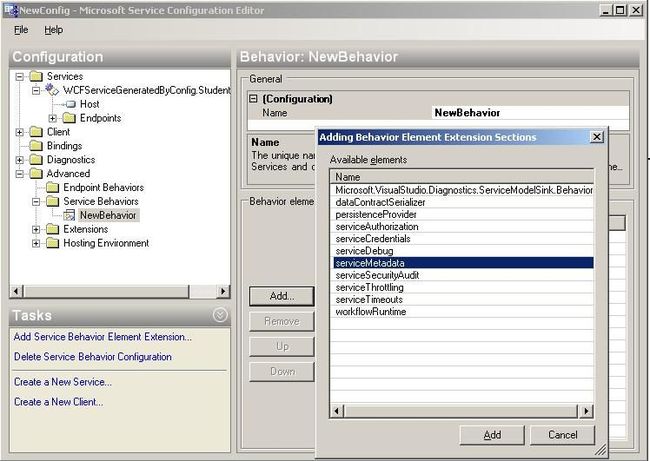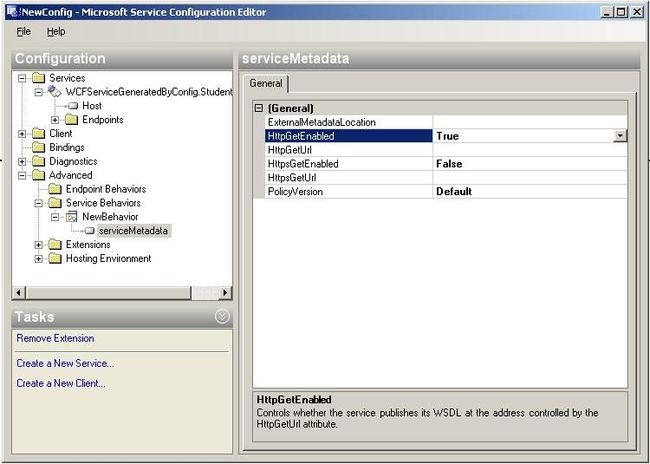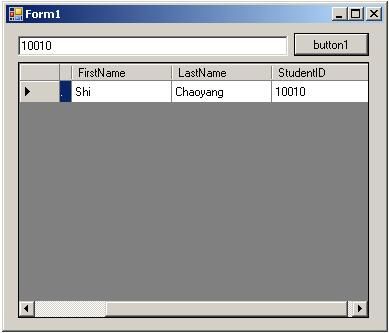基于net.tcp的WCF配置实例解析
本文主要通过文件配置来讲解如何编写一个基于net.tcp的Windows Form小程序。
使用的工具
涉及的工具有:
SvcUtil.exe
WCF Service Configuration Editor
服务器端的配置步骤
首先让我们来开始编写服务器端,服务器端用的是Console Application。
由于我们的软件是一个能够通过学生ID来获取学生姓名的小程序,所以,首先必须得有一个StudentInfo实体类:
using System.Runtime.Serialization; namespace WCFServiceGeneratedByConfig { [DataContract] public class StudentInfo { int studentID; string lastName; string firstName; [DataMember] public int StudentID { get { return studentID; } set { studentID = value; } } [DataMember] public string FirstName { get { return firstName; } set { firstName = value; } } [DataMember] public string LastName { get { return lastName; } set { lastName = value; } } } }
在这个实体类中,DataContract代表数据契约,DataMeber代表数据成员,加上这些Attribute后,能够传送给Client端。
然后是一个接口,这个接口定义了服务契约和操作契约:
using System.Collections.Generic; using System.ServiceModel; namespace WCFServiceGeneratedByConfig { [ServiceContract] public interface IStudentService { [OperationContract] string GetStudentFullName(int studentId); [OperationContract] IEnumerable<StudentInfo> GetStudentInfo(int studentId); } }
然后是具体的实现方法:
using System.Collections.Generic; using System.Linq; namespace WCFServiceGeneratedByConfig { public class StudentService : IStudentService { List<StudentInfo> list = new List<StudentInfo>(); public StudentService() { list.Add(new StudentInfo { StudentID = 10010, FirstName = "Shi", LastName = "Chaoyang" }); list.Add(new StudentInfo { StudentID = 10011, FirstName = "Liu", LastName = "Jieus" }); list.Add(new StudentInfo { StudentID = 10012, FirstName = "Cheung", LastName = "Vincent" }); list.Add(new StudentInfo { StudentID = 10013, FirstName = "Yang", LastName = "KaiVen" }); } public string GetStudentFullName(int studentId) { IEnumerable<string> Student = from p in list where p.StudentID == studentId select p.FirstName + " " + p.LastName; return Student.Count() != 0 ? Student.First() : string.Empty; } public IEnumerable<StudentInfo> GetStudentInfo(int studentId) { IEnumerable<StudentInfo> Student = from p in list where p.StudentID == studentId select p; return Student; } } }
这个方法里,我们有两个函数,一个能够根据学生点获取学生全名,另一个是根据学生点获取学生的实体对象。
好了,让我们来编译这个项目,得到一个WCFServiceGeneratedByConfig.exe文件。
然后,我们需要配置文件来让服务器端启动,所以这里我们要用WCF Service Configuration Editor
工具来进行,由于在VS2008 和VS2010中带有这个软件,我们可以直接通过菜单->Tools->WCF Service Configuration Editor来打开。
首先,点击File->New config, 打开Service的Configuration界面。
然后,点击Create a new service…,在弹出的界面中,我们选择刚才生成的那个WCFServiceGeneratedByConfig.exe文件。双击之后,软件自动显示出了里面含有的Service:
点选那个Service,然后点击两次next,我们会看到出现了选择Communation Mode的界面,这里由于我们用的是net.tcp,所以我选择了第一个:TCP。
然后点击Next,我们会看到要我们填写EndPoint,这里我随便填写了一个:
之后,点击Next知道Finish,然后,我们的最基本的配置就结束了。
回到Config界面之后,我们点击Advanced->Service Behaviors->New Service Behavior Configuration,在弹出的界面中,我们点击Add->serviceMetadata:
然后点击Add,我们就添加了一个Behavior Element。点击刚刚生成的serviceMetadata节点,在显示的界面中,设置HttpGetEnabled为true。
然后点击原来的Service节点下的Host节点,在Base Address栏目下单击Add,添加如下的Base Address:
最后点击OK。然后点击菜单File->Save As 保存到项目文件夹下即可。
这里是生成的代码:
<?xml version="1.0" encoding="utf-8"?> <configuration> <system.serviceModel> <behaviors> <serviceBehaviors> <behavior name="StudentBehavior"> <serviceMetadata httpGetEnabled="true" httpsGetEnabled="false" /> </behavior> </serviceBehaviors> </behaviors> <services> <service name="WCFServiceGeneratedByConfig.StudentService"> <endpoint address="net.tcp://127.0.0.1:50001/StudentServiceEndPoint" binding="netTcpBinding" bindingConfiguration="" contract="WCFServiceGeneratedByConfig.IStudentService" /> <host> <baseAddresses> <add baseAddress="net.tcp://127.0.0.1:50001/StudentServiceEndPoint" /> </baseAddresses> </host> </service> </services> </system.serviceModel> </configuration>
这一步做完后,我们需要让服务能够启动,怎么启动呢?请看下面的代码:
using System; using System.ServiceModel; using System.ServiceModel.Description; namespace WCFServiceGeneratedByConfig { class Program { static void Main(string[] args) { using (ServiceHost host = new ServiceHost(typeof(StudentService))) { ServiceMetadataBehavior smb = host.Description.Behaviors.Find<ServiceMetadataBehavior>(); if (smb == null) host.Description.Behaviors.Add(new ServiceMetadataBehavior()); //暴露出元数据,以便能够让SvcUtil.exe自动生成配置文件 host.AddServiceEndpoint(typeof(IMetadataExchange), MetadataExchangeBindings.CreateMexTcpBinding(), "mex"); //开启服务 host.Open(); Console.WriteLine("Service listen begin to listen..."); Console.WriteLine("press any key to teriminate..."); Console.ReadKey(); host.Abort(); host.Close(); } } } }
代码中的注释部分非常重要,我们一定要添加,否则下面的步骤不能进行,具体的原因,参加我的另一篇文章:在net.tcp模式下,由SvcUtil.exe生成代理类文件和配置文件
然后运行这个ConsoleApplication。
接下来,找到SvcUtil.exe,C:\Program Files\Microsoft SDKs\Windows\v7.0A\bin\SvcUtil.exe,在CMD窗口下运行如下命令:
C:\Program Files\Microsoft SDKs\Windows\v7.0A\bin\SvcUtil.exe net.tcp://127.0.0.1:50001/StudentServiceEndPoint
这样,这个小工具就会自动的给我们生成代理类和配置文件
Microsoft (R) Service Model Metadata Tool [Microsoft (R) Windows (R) Communication Foundation,版本 3.0.4506.2152] 版权所有(c) Microsoft Corporation。保留所有权利。 正在尝试使用 WS-Metadata Exchange 从“net.tcp://127.0.0.1:50001/StudentServiceEndPoint”下载元数据。此 URL 不支持 DISCO。 正在生成文件... E:\WCF\WCF_ChatRoom\StudentService.cs E:\WCF\WCF_ChatRoom\output.config 请按任意键继续. . .
客户端的配置步骤
接下来,新建一个WindowsFormsApplication程序,将这个代理类拷入,配置文件修改名称为App.config拷入,
然后在Form1.cs中拖入一个文本框,一个按钮,一个DataGridView,后台代码如下:
using System; using System.Collections.Generic; using System.Windows.Forms; using WCFServiceGeneratedByConfig; namespace WindowsFormsApplication3 { public partial class Form1 : Form { public Form1() { InitializeComponent(); } private void button1_Click(object sender, EventArgs e) { Action action = new Action(Bind); action.BeginInvoke(new AsyncCallback((iar) => { Action actionEnd = (Action)iar.AsyncState; actionEnd.EndInvoke(iar); }), action); } private void Bind() { StudentServiceClient client = new StudentServiceClient(); IEnumerable<StudentInfo> x = client.GetStudentInfo(Int32.Parse(textBox1.Text)); dataGridView1.Invoke((Action)(() => { dataGridView1.DataSource = x; })); } } }
启动这个实例,输入学生ID,我们成功得到了服务端返回的值。
在本机和公网上的运行结果
那么能不能在公网上使用呢?呵呵,这个当然,将服务端拷贝到外网的一台机器上,然后修改服务器端的配置文件中的地址为:net.tcp://169.*.*.124:50001/ StudentServiceEndPoint,然后将本机的配置文件中的地址也修改为这个,最后运行,依然能够得到返回的结果。
源代码下载
